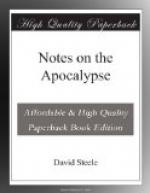Ever since the revelation of mercy to fallen man, God deals with mankind, not in essential or absolute character, but by covenant in economical standing. All along since that epoch in the history of this world, “the Father judgeth no man, but hath committed all judgment unto the Son.” As yet, however, the Son is not brought upon the stage in the apostle’s present view. The Son has his appropriate place in the vision, where he will appear as Mediator. In the conflict to be carried on for twelve hundred and sixty years by the combined powers of earth and hell “against the Lord and his Anointed,” we have the agencies exhibited in these two chapters only on heaven’s side. The opposing hosts will afterwards appear.
4. And round about the throne were four and twenty seats; and upon the seats I saw four and twenty elders sitting, clothed in white raiment; and they had on their heads crowns of gold.
5. And out of the throne proceeded lightnings, and thunderings, and voices: and there were seven lamps of fire burning before the throne, which are the seven spirits of God.
Verses 4, 5.—To John’s view, the “throne” seen from one side would appear to be surrounded by a segment of a circle, within which were “four and twenty seats,” (thrones,) occupied by an equal number of “elders.” In society divinely organized “elders” have always been the legal representatives of God’s covenant society in civil and ecclesiastical relations. (Exod. iii. 16; Acts xx. 17.) These “four and twenty elders” represent the collective body of God’s people under the Old and New Testaments,—the “twelve tribes of Israel” and the “twelve apostles.” (ch. vii. 4; xxi. 12-14.) Their “white raiment” and “crowns of gold” indicate their legal state and moral purity,—their justification and sanctification, as also their promotion to honour, to “reign as kings.” (ch, i. 6; v. 10.) ["reign on the earth,” ch, xx. 4.] Allusion is had to the terrific scene at Sinai by the “lightnings,” etc., when “Moses did exceedingly fear and quake,” importing that God, “our God, is a consuming fire” to all his impenitent, especially antichristian, enemies, even under the milder economy of the New Testament. (Heb. x. 28-31; ch. xx. 10.) The “seven lamps of fire” are explained to mean “the seven spirits of God,” in allusion to the golden candlestick in the temple, (Exod. xxxvii. 23; Zech. iv. 2,) and signifying the gifts and graces of those who are “baptized with the Holy Ghost and “with fire.”




